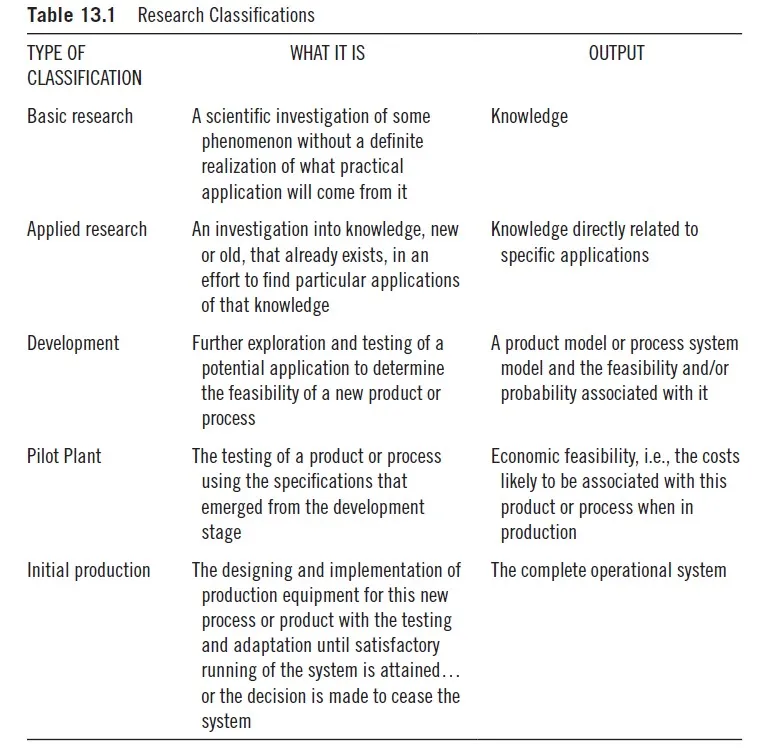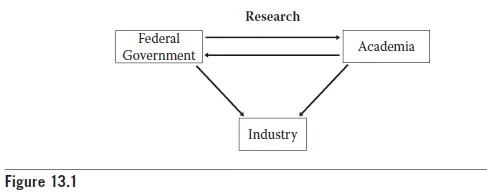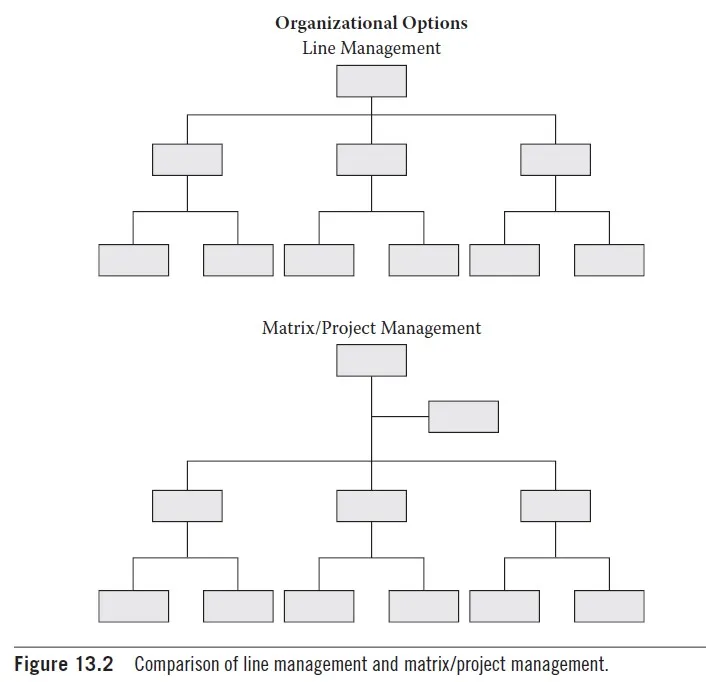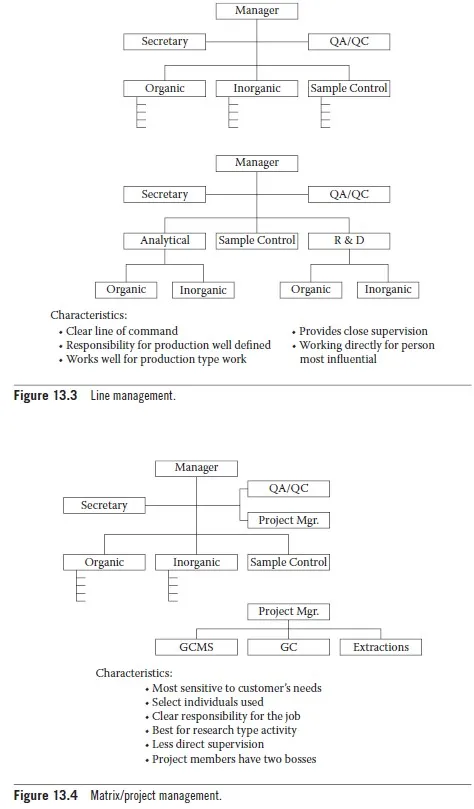In this chapter we are going to address issues such as:
- What is research and development?
- Why is it needed? (If, in fact, you think it’s needed.)
- How does the research and development function relate to the rest of a company?
- what’s your laboratory structure?
- How do your research and development and technical services differ?
- How will you direct research and development?
- what’s your company’s chain of command for research and development?
It may be helpful to define research and development separately. Simply put, research is exploring new ideas. Development will be considered a phase of research or the following step beyond research. Table 13.1 details various aspects of research and development. As a project advances from basic research to production, the possibilities related to it increase significantly. Basic research doesn’t always have an end result. More predictability surrounds applied research, and predictability continues to extend as an inspiration approaches the assembly stage which will generate money.
A review of Table 13.1 will show that as we increase from basic research to production, the chances related to what we are going to learn increase significantly. We aren’t sure what we are going to get out of basic research. Then we’ve got more predictability associated with applied research, and so more as we go down the chart. Another thing also changes. The probability of cash cominginto the firm increases more because the project gets closer to the assembly stage. Most companies want to urge to the present stage (the stage of making money) as soon as possible.

Table 13.1 shows the varied classifications of research and even includes initial production under the heading of research. As you review this table, you’ll choose other words to explain what occurs within your company, but this chart should offer you an honest overview of the categories of research and why, here, we are considering development as a stage of research.
Some companies don’t conduct their own research. They contract it bent research organizations. Figure 13.1 indicates that industry, the federal government, and academia conduct an outsized style of researchprojects. Industry investigates relevant products and processes. Small companies with strong research capabilities are purchased and became divisions of larger companies. In fact, some companies are founded with the conceive to be purchased by a bigger company. Many agencies of the federal perform research applicable to their operations, and far of the knowledge is accessible to the final public. Information about various agencies, their responsibilities, and how to contact them will be found at http://www.usa.gov/

Benefits of Research and Development
Research and development functions keep an organization alert to new developments and future possibilities. Research and development activities yield results that cure illnesses, save lives, provide a high quality of life, generally make work easier and life more pleasurable.
Another valid reason is solely to satisfy our curiosity about things.
If your company manufactures golf tees or clothespins you will justifiably question the necessity for extensive research, but improvements are possible even in industries that appear to not rely on research breakthroughs.
If you made manual typewriters and chose to not advance to electric, electronic, and computer data processing capabilities, you would probably not have a market anywhere within the world.
Around 1967 and 1968, 90% of all watches were manufactured in Switzerland, then in 1968, the watch was invented. People now could see the particular digits that will indicate the time of day.
Initially, you had to push the tiny button so as to urge the watch to illuminate. Subsequently, the watches have improved over the last 40 years and now you only have a look at them and time is displayed along with various other information, and far more information may be presented at the touch of a button. land watchmakers believed that people wouldn’t want to vary and would like the previous style—the way watches have always shown the time—and hence, did not immediately get into the watch and thereby lost a big share of the market. On the opposite hand, various companies in the us started manufacturing digital watches. The digital watch became commonplace. By the way, where does one think the digital watch was invented? If you haven’t guessed, it had been invented in Switzerland. The market has swung back to the “regular, analog” watches, except for a protracted time digital watches were very hip.
Here’s another case. One company had the research and development capability to search out a replacement use for a rejected product. within the early 1970s, Upjohn discovered that its minoxidil prescription medicine accustomed reduce hypertension caused excessive growth of hair. watching this side effect from a replacement view, Upjohn scientists investigated its efficacy for hair growth. In 1988, the merchandise (renamed Rogaine) was put on the market as a pharmaceutical formulation to help hair growth.
Rogaine sales total a few quarter of a billion dollars annually.
A new technology now in common use is that the global positioning system (GPS) which will pinpoint a location to within 30 feet. Initially used by the military and civilian aviation, it’s now available to be used in automobiles. Hikers use handheld GPS units to navigate.
Things seemingly as simple as cell phones (which don’t seem to be really that simple) that do such a large amount of things including taking pictures and recording voices are the results of R & D. the flexibility of police departments to trace the particular towers that conveyed telephone calls is the results of R & D. Making automobiles more fuel efficient and also making automobiles that run on aside from oil based fuels are research efforts that benefit us. Gene splicing specifically, and biotechnology more generally, still cause more productive food harvests and to new pharmaceuticals. These are some samples of how research has helped us. It costs plenty of cash to conduct research and more to require the results through development, but the rewards are often great.
Whether an organization needs research and development, and the degree to which these functions are needed, depend upon the corporate and its philosophies, as determined by the board of directors, the CEO, and other executives.
R & D and Its Relationships with Other Areas of the corporate Where do research and development functions fit within a company?
In Chapter 1 we compared a business to a mobile and showed how each area connected to other areas and the way any major change necessitated a shift of the others to regain equilibrium. A business continually tries to displace the equilibrium by moving forward; joined area changes, the others must change to accommodate it.
When research and development efforts design or improve a product or process, the areas of sales, marketing, manufacturing, and others must adapt to regain equilibrium. Let’s take a case where research and development improves an existing process to avoid wasting time and money.
By employing a costlier material, the corporate can increase production.
The increase in product made per hour far offsets the price of the new material, resulting in increased profit. Assuming the corporate makes other products, it should prefer to sell more of the item produced via the new process because it can increase production without a significant capital expenditure. (It already obtained the research and development.)
Sales and marketing must now be prepared to sell more.
No division, department, or area stands alone. If it did, it would constitute a separate company, and could be counterproductive to the corporate goals. The essence of a business is for all of the parts to figure together. Management’s role is to realize that symbiosis.

Laboratory Structure
A small company might not need a laboratory. A medium-sized companymay have one laboratory that handles research and development,technical service functions, and internal control. As an organization expands, the functions of internal control, technical service, and research and development become more distinct. we’ve got chosen in this course to treat them as separate entities, as is that the case in large companies.
The size of a corporation, the philosophies of management, and the nature of its products determine whether research and development will or won’t be a separate function.
The two primary organization types common in laboratories are line management and matrix or project management, both of which are shown in Figure 13.2. the road management option is shown in more detail in Figure 13.3, and Figure 13.4 illustrates matrix or project management.

Observations of the figures show that for administration there’s a clear line of command. this can be best for a production type situation.
Looking at the project management outline, we see that it’s the simplest for research type activity. It also has the smallest amount direct supervision, a characteristic which is sweet for an exploration function. Research people don’t like to be supervised too directly. However, we see that the project members have two bosses: the laboratory manager and also the project manager.
Another way of observing this, and it’s the way that exists in many places, is that the project manager could also be a highly skilled research one who is directing the varied laboratory people involved during a particular project.
But the laboratory people really report on to the laboratory manager, who is that the one who is liable for their evaluations and their raises and every one those treats. Where does one think their dedication is going to be? The project management option feels like it works very well, and it can work o.k., provided the sensitivities are taken into account first hand.
As with any job in any organization, an individual has to know who his/ her boss is. someone wants to grasp, and encompasses a right to understand, whose input are going to be considered—and after all by whom that input are considered— in their next evaluation for promotion and/or wage hike.
People always have as their priority the work assigned to them by the person who controls their salary, no matter whatever other tasks and responsibilities fall their way. Whatever system you choose, make sure that everyone knows the hierarchy. For efficiency and for ethics reasons don’t allow them to think person A is evaluating them while person B is truly doing the evaluating. to place it more bluntly, “their first loyalty is to the one who pays them” and that they should know who that person is.
The most efficient practice is to produce all and sundry in a very laboratory with a whole range of kit, but that’s idealistic and typically not affordable. Therefore, you’ll devise another arrangement. Some highly complex instruments like a spectroscope require a specialist to run it. Mass spectrometers frequently function research instruments and fill another role by processing samples submitted by other areas. Which system—the line, matrix, or a combination—is best for you? Only you’ll be able to decide supported available equipment, features, advantages and drawbacks, and costs.
Comparison of Research and Development and Technical Service
Research and development and technical service are different functions as noted earlier. Both functions could also be handled by one individual or small group in a very small firm. during this case, management may want to stay track of the research and development projects separately from technical service projects for financial purposes, and calculate returns on investment from each function. this can be vital in a very small growing company within which management might want to expand one function only. If the research and development projects have generated more return on investment (ROI) supported new or improved products or processes than the technical service unit, management may wish to speculate more cash into research and development to earn
more money within the future.
In a large company, the 2 functions are distinct and have separate staffs. Chapter 12 discussed the technical service function. This chapter focuses on the research and development function, and by now the difference should be clear. Generally, technical service handles troubleshooting for existing products or processes and “preventive” activities. The research and development function develops new products and processes or attempts to enhance existing ones even when there’s no problem.
Directing Research and Development Operations
Directing the research and development function of an organization requires effective people skills. rather more are said about people skills. Research and development people are a “different breed.”
A good research and development person, department, or division (for the sake of dialogue, let’s use “department”) can produce innovations that generate huge income. it’s paradoxical that productivity is typically difficult to live. Of course, in any applied research activity, the goal is defined before work starts, but the R & D success isn’t measured; it’s estimated. Compare this to the sales function whose performance is measurable by comparing current sales to the previous year’s sales.
You may signifies that each one sales of a specific new product resulted from its invention by an enquiry and development department.
Research and development will agree; the business department might not agree and can assert that sales skill was a contributing factor. This indicates the issue of measuring the productivity of a quest and development function.
It is appropriate now to hide productivity measurement. Generally, productivity is predicated on attainment of goals. The manager’s responsibilityis to direct his department toward meeting those goals.
How does one measure the productivity of a search and development department? Certain parameters may be measured:
- The number of projects completed in a particular period.
While this can be not a measure of productivity, it reveals information about the functioning of the department. The time spent on a project measured as persons/day is also very small; i.e., an organization may pursue lots of small projects at only once.
This doesn’t mean the projects don’t seem to be productive. On the other hand, we cannot claim that a project was more productive because it required longer. the character of the business determines the amount of projects.
- the amount of projects carried at a selected point in time.
This includes a similar answer; project activity depends on the nature of the business and also the complexity of products or processes involved. No correlation exists between the number of projects carried at anybody time and department productivity. Researchers must sometimes sit up for results of an interim evaluation of a project. this is often not a delay; the required wait time should be incorporated into a project schedule and staff can work on other projects within the interim. For this reason, the quantity of projects at a given time isn’t an indication of productivity.
- Sales generated by research and development efforts.
If contributions of other departments like sales, marketing, and manufacturing weren’t involved, you’ll consider income from inventions or new processes as a measure of the success or productivity of R & D. The result wouldn’t be a dollar-for-dollar comparison of latest product sales but it might provide a basis for a project-to-project comparison. Keep in mind the interruption from invention to income flow. a good more complex issue is measuring the productivity of a project aimed at improving a process. This involves measuring the increased efficiency of the improved process.
- Research and development director’s monthly report.
This is the smallest amount reliable and may be a miniature version of an annual report intended for in-house use. It provides executives and others with information about the progress and standing of various projects. It mustn’t cause the demise of the career of the director who wrote it. Whether the results described were good or not good, it’s always advisable to detail the subsequent steps planned for current projects. This tells readers where you plan to go and is often a positive sign.
The point of this section is that you simply cannot measure the productivity of a look and development department as precisely as you can measure sales or manufacturing performance. Sales figures are tracked consistently. Manufacturing efficiency is measured by comparing inventory produced to inventory returned. While scientists like to be precise, non-quantitative terms (mediocre, good, very good, excellent) is also the sole thanks to describe results. Research and development people depend upon faith and their track records. However, better measures are required.
The preferred method is to interrupt a project into phases or steps, define the results desired for the individual steps, and compare the results of every phase to the projected or desired results through the end of the project. Financial implications of research are important but a researcher’s primary need is to grasp a way to plan a project and measure successes along the road to completion.
If you direct a pursuit and development function, it’s imperative to give researchers a high degree of freedom. Remember the characteristics of a look person? He or she may be a positive thinker, a daydreamer, and an explorer who requires freedom. How does one manage this sort of person? You provide an environment that’s conducive to positive thinking, daydreaming, exploring, and freedom, within certain limits, of course. the most point is that research and development personnel require more freedom and fewer direction than line employees. Research and development scientists should tend more freedom than internal control personnel. internal control people are expected to follow certain procedures and infrequently modify them as required. Research and development people require the liberty to rethink and modify all the time.
Does this mean that you simply provides a scientist an entire laboratory with an unlimited budget, deposit his paychecks, and discuss with him at review time? No, it means you hear what staff members say, direct them occasionally, perhaps more subtly or more firmly if they wander away course from the goals of the corporate or department.
Directing a quest and development operation is in large part a guiding and coaching style of managing.
You may ponder whether granting an excellent deal of freedom to a research and development scientist will cause projects outside defined parameters or a scarcity of communication. These unexpected results are unlikely because research people prefer to discuss their discoveries.
We all want recognition and researchers are not any exceptions. This does not mean you ought to sit back and wait until a staffer involves you to report a discovery. Giving your staff freedom doesn’t mean relinquishing control. Conduct periodic meetings, disseminate data relevant to priorities, and seek information from your staff.
If you retain the reins loose and attract genuine research and development people, you may have a productive department.


3 Comments